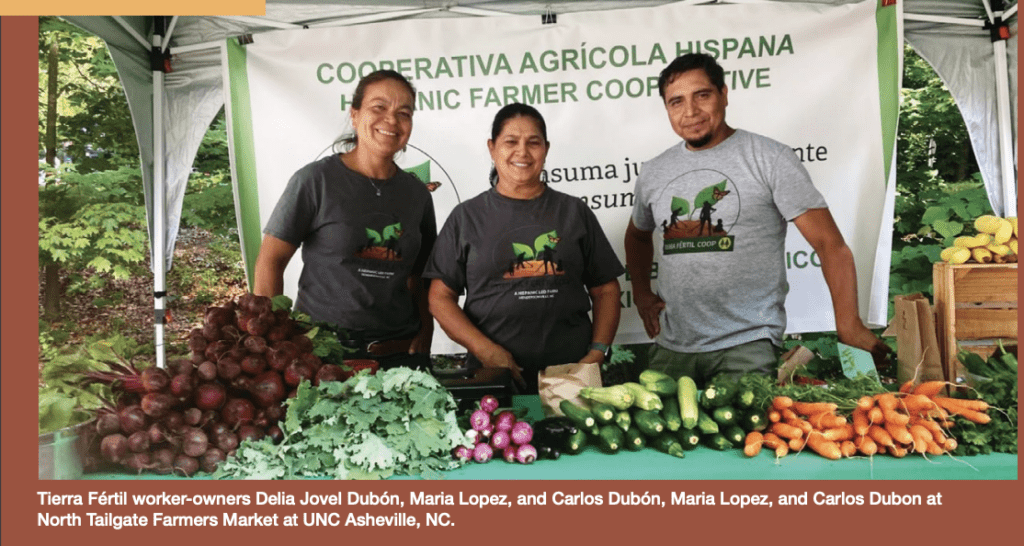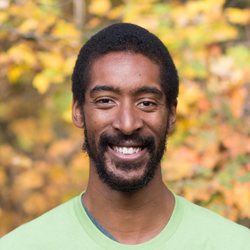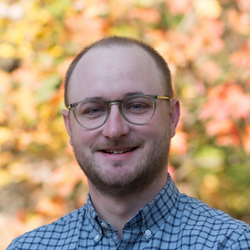
Share this story
-
Pittsboro nonprofit @rafiusa released a guidebook last fall examining the history of racial land loss in the U.S. and how faith communities can respond today. Take a look at this Q&A with two of the people who worked on the project.
-
“It’s clear that churches of all denominations have a lot of land, have a lot of assets and can definitely be a key part of the solution when it comes to land loss and working with farmers in unique ways,” said David Allen, with @rafiusa.
Rural Advancement Foundation International (RAFI-USA) is a nonprofit in Pittsboro that “challenges the root causes of unjust food systems, supporting and advocating for economically, racially, and ecologically just farm communities.”
Last fall, RAFI’s Come to the Table initiative published, “The Land Cries Out: A Guide to Racial Land Loss in the U.S.,” as a tool to learn more about land access, the history of racial land loss, and how faith communities can respond.
“The Come to the Table program at RAFI seeks to empower faith communities to participate in the creation of a just food system through collaboration, capacity building, and advocacy,” the guidebook says. “We believe that this guidebook is a reflection of that mission. A more just food system begins with access to land, which is currently in danger; farmland in the United States is decreasing at an alarming rate.”
North Carolina ranks second among states predicted to lose the most farmland by 2040, according to a report from the American Farmland Trust. At the same time, agricultural production contributes over $92 billion to our state’s economy every year.
Attempting to solve this problem requires looking back to the history of “land ownership” in the United States, the RAFI report says. Here is a brief look at some of the history the guide explores:
- The Doctrine of Discovery and Native American land loss, including the Indian Removal Act and Indian Reorganization Act.
- Black land loss and the impacts of discriminatory distribution of land under the Homestead Acts, heirs’ property — real estate passed from one generation to the other with little to no legal documentation — and the lynching of affluent Black property owners.
- Immigrant land loss and the impact of mass deportations, California Alien Land Laws, and Japanese Interment.
- Instances of restitution in the last 30 years among farmers and ranchers, against the United States Department of Agriculture (USDA).
The guide also includes highlights two solution-oriented examples for faith communities:
- A partnership between Calvary Episcopal Church, in Fletcher, and the Tierra Fértil Coop, a Hispanic, worker-owned farm cooperative in Hendersonville. The partnership began with the cooperative introducing Spanish-speaking residents to the church’s client-choice food pantry, and educating church leaders on culturally appropriate foods. Eventually, the church offered to rent a plot of land to Tierra Fértil to grow on.
- Pastor Callie Walker, a licensed local pastor in the Virginia United Methodist Annual Conference, bestowed most of her family land to the Central Virginia Agrarian Commons, a community land trust she serves on the board of. The trust is working to develop a regional food system surrounding the Richmond area, specifically for African Americans and people of color, to match up people and land.
“This resource seeks to stress the reality that not only must action be taken, but also that faith communities in particular are responsible to respond, rooted in justice and mercy,” RAFI’s guide says.
EdNC spoke with Jarred White, RAFI’s farm and faith partnerships project manager and primary author and researcher for the guide, and David Allen, RAFI’s Come to the Table project manager, about the idea for the guide, what they hope readers will take away, and what comes next. The interview has been edited for length and clarity.
You can download and read the full report on RAFI’s website.


EdNC: Can you start by talking about how the idea for this report came about? How did it change along the way, if it did?


White: At Come to the Table, a lot of our work involves, on the one hand, partnering with local churches and faith communities to address food insecurity. On the other hand, through RAFI’s Farmers of Color Network, we have a lot of connections with farmers of color throughout North Carolina, especially, but throughout the southeast as well.
So seeing each of these two different communities, especially on the farmer side, it was easy for us to hear from farmers regarding their own experiences of systemic racism, of issues with getting land, keeping land, access to land. For us, it felt like it was in alignment with both our mission and something that we were hearing from partners — that addressing racial land loss and communicating that to a wider audience is something that would have been valuable. So we kind of worked from there and did some research.
Our hope is that whether it’s a faith community, a nonprofit organization, whether you’re a farmer, farm worker, that this would be a resource that you can use to learn more about racial land loss — how it’s affected farmers up until now, how it still affects farmers, and a few ways that would help.


Allen: There’s just a lot of energy internally, between Jarred, Justine, and I and other RAFI staff, around this issue of land loss, especially as it pertains to how faith communities can be a part of the solution.
I think a big part of it, specifically for our audiences, is that we do recognize that, although it’s immeasurable to find out how much land (the) church owns in North Carolina, it’s clear that churches of all denominations have a lot of land, have a lot of assets, and can definitely be a key part of the solution when it comes to land loss and working with farmers in unique ways. That’s something that I think we hope to emphasize enough to work with churches in the future as well, once they’ve read this guidebook, is thinking creatively and imaginatively about the ways in which they can use land, resources, assets, to be a part of the solution.
It’s clear that churches of all denominations have a lot of land, have a lot of assets and can definitely be a key part of the solution when it comes to land loss and working with farmers in unique ways.
David Allen, RAFI’s Come to the Table project manager
EdNC: What surprised you or stood out during the research and writing process?
White: Maybe from a bit more of a personal perspective, I myself have been personally affected by heirs property issues in my family. In doing the research, something that was surprising, and disappointing, and somehow illuminating, was how common for a lot of Black Americans who own land — especially in the southeast — how often and regularly they find themselves in a position where they have land that was family land, and because of how heirs property laws work, they can end up losing that.
Once we were able to really compile all the information, I think another thing that struck me was that each of these individual laws or historical events, perhaps on their own, would not be so devastating or as consequential, but seeing them all put together in one guidebook showed the persistence in how these white supremacist forces have been continually mitigating land loss.
At least for me, it kind of changes my perspective from, “Wow, several historical bad things have happened,” to “Wow, it’s a miracle that someone has been able to keep their land.” We have a couple of farmers that might be second-generation, third-generation, fifth-generation farmers, and after having completed this process, that feels like a miracle.
Allen: We didn’t really pick policies or stories that were things people never heard of before, but the stories that a lot of us are told when we grow up in school that are in curriculum that you don’t get the full picture of. That’s a really important thing that we try to talk about in all of our narrative change work, in kind of the stock stories that you hear, what are the hidden stories, concealed stories, and resistance stories?
I think it’s something that is eye opening, and a good reminder to all of us that the history that we’re taught is not always the truth of what really happened.
EdNC: What are some of the general themes or information you hope people will take away from this report?
Allen: I do think that we try to end positively, to give faith communities specifically a little bit of hope about the ways that they can play a role in this. It would have been a shame if we would have just ended with just the facts and not talked about what’s happening presently.
Then the basic educational part of it — we just want to give this information out to folks, too. And then the second part is examining how these land laws, how all these stories that we’re referencing, set the stage for modern day economic, political, social realities. Just showing that this is not something that has happened in a vacuum, I think is something that we hope folks will walk away from thinking about as well.
EdNC: The report talks about the need for actions to be taken, and specifically calls on faith communities to respond. Can you talk more about that call in the report, and the unique opportunity you see for faith communities in addressing this issue?
White: The first thing that comes to mind for me is every faith community I’ve been a part of, on some level, food and community meals have some role in the life of that community. It might be a meal after a Sunday morning service that happens every week or once a month. It might be special occasional get-togethers. But whatever it is, food is an integral part of many faith communities.
So for us, it might just start with the idea that there are farmers that are close to a faith community. They may or may not know those farmers, but those farmers are there, and those farmers are looking for partners, and they’re looking for community support and market access. For an area that many churches already have a line item in the budget for — food — that’s a pretty straightforward way to say, “Hey, you’re going to be buying food anyway, you’re going to be buying fruits and veggies, produce, meat, whatever it is, anyway. Instead of purchasing it from the local, large chain supermarket, you could purchase it directly from a local farmer, for whom it would be a very significant partnership.”
Allen: The guidebook included a section on the theological convictions behind care for the land. Although that might not be paramount when it comes to faith communities, the way that I see it is that if faith communities get it from a theological standpoint — if it’s connected to Scripture, if it’s connected to the stories that we all grew up hearing — and then they understand the history of it, if they read this guidebook, then one plus one equals some type of action. It’s not going to be the same for every church, but kind of opening up the space for the faithful imagination for the church to begin to think about the way in which their community specifically can respond to this is ultimately the goal, no matter what they end up doing.
EdNC: What feedback have you gotten on the report so far?
Allen: The guidebook is tied to a simulator as well. We’ve had folks reaching out and saying, “Hey, I loved to read this guidebook. And now you can come do this too, with my community.” That’s been the biggest feedback we’ve gotten so far.
EdNC: How can folks get involved after reading this report? What’s next for RAFI?
White: The majority of the content in the guidebook is based on content that we use to design a racial landmarks simulation, that’s designed to be a half day experience. So it’s a more interactive version of the guidebook that allows participants to learn more not just about historical facts, but to hear impact statements from those who are directly affected in real time, through different kinds of first-person narratives.
And then because RAFI is an organization, we have partnerships with more food-based organizations, agriculture organizations, farm and farmworker organizations. Our hope is this guidebook would open up doors for new partnerships and create space for us to make new connections that maybe we couldn’t have imagined previously. I know we’ve already got a few requests from a few different organizations throughout the country. So the hope is increasing connection.
Allen: One big one will be the 2024 conference, that’s going to be held in October in Rocky Mount. Our theme is food, land, and sacred stories, and I think we’ll probably have the simulator there as well.
EdNC: How can EdNC readers just learning about your work get involved?
White: The first thing that comes to mind is just download the guidebook, to check it out. There are several links to other organizations doing great work. Even if you might already be familiar with RAFI and Come to the Table, you might learn about another organization that more closely aligns with work you’re already doing. And it’s useful to understand who’s doing work in your own backyard and throughout North Carolina.
I do believe that there are plenty of North Carolinians who are concerned about the resiliency of our food systems, food access, and food insecurity. So learning that there are organizations who are already doing that work, I think for a lot of people, is helpful in terms of getting involved because they might not feel like they have to reinvent the wheel.
If you’re interested in Come to the Table facilitating an immersive and interactive experience featuring guided facilitation of racial land loss-focused content with your faith community, nonprofit, or other interested organization, email Jarred White at jarred@rafiusa.org. Also, if you would prefer a print version of the guidebook, email cttt@rafiusa.org. You can also join RAFI’s email list here.
Behind the Story
This story is a part of EdNC’s faith work. If you’d like to share your faith story with us, reach out to hmcclellan@ednc.org.

